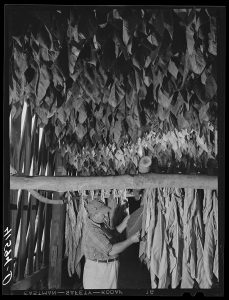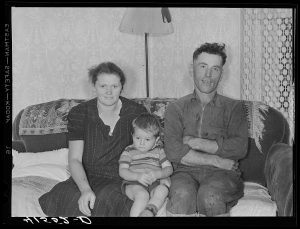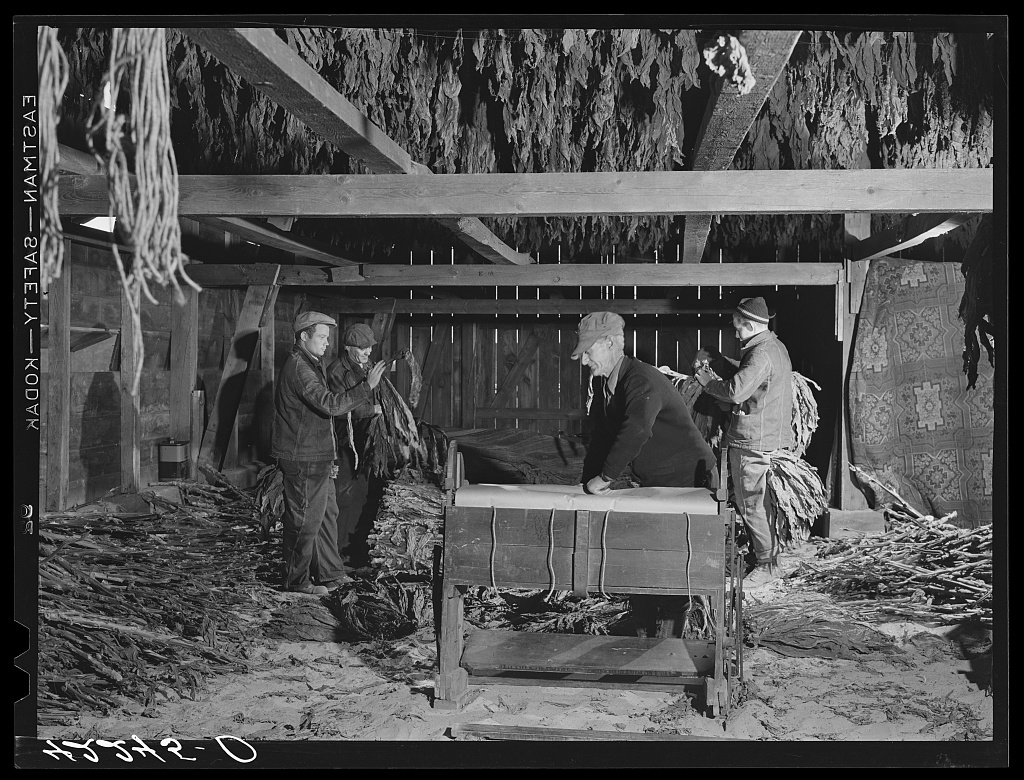By Nancy Finlay
Towards the end of the 19th century, most of the Polish immigrants who came to Connecticut settled in cities and worked in textile mills and other industries. Some, however, were farmers or would-be farmers, who dreamed of owning their own land and running their own farms, much like generations of immigrants who came to America before them. Many of them found work on tobacco farms in the Connecticut River Valley that specialized in growing the tobacco used for cigar wrappers.
Michael Zukowski Buys a Tobacco Farm

Mr. Frank Brockoneski, Polish tobacco farmer and FSA (Farm Security Administration) client with some tobacco raised on his farm near Windsor Locks ca. 1940 – By Jack Delano, Library of Congress Prints and Photographs Division. Used through Public Domain.
One of these immigrants was Michael Zukowski, who was born in Poland around 1867. He arrived in Suffield with his family in 1888 and found a job working on Calvin Spencer’s tobacco farm for $8 a month. He married in 1898 and became a naturalized citizen in 1900. By 1905, he had saved enough money to purchase a nearby farm for $2,800.
Like many Polish farmers, Zukowski had a large family—five sons and two daughters. The 1910 Census also lists a hired man, another Pole, Joseph Yasinski, but no employees are listed in later censuses as the children grew older. Zukowski’s farm was quite small, with only 20 acres devoted to tobacco. In 1919, he bought a second piece of property, the John Talmadge place, more than doubling his holdings.
Other Polish Tobacco Farmers in Suffield
Michael Zukowski was by no means the only Polish tobacco farmer in Suffield. Most of his neighbors were also Polish farmers, primarily specializing in tobacco. John Turek and Charles Lucosic bought the Granger place on East Street in Suffield in 1911. An article in the Hartford Courant described it as “the oldest house in Suffield.” According to the article, the two men had been in the United States for about eight years—Turek had been head foreman at the Herman Ude Market Garden and Tobacco Plantation, while Lucosic was foreman at the Charles Whittemore Farm, both located in West Suffield.
In just one week in 1919—the year that Michael Zukowski bought his second farm—four other Polish residents bought Suffield farms. The 1930 Census lists no fewer than seven Polish farmers living on East Street: Stanley Zukowski, John Turek, Charles Lucas (Charles Lucosic anglicized his name), Anthonie Turek, John Zak, Alec Kosinski, and Alexander Regal—all with large families of young children. Other towns in the Connecticut River Valley also had large concentrations of Polish farming families.
The FSA Documents Tobacco Culture by Polish Farmers

Mr. and Mrs. Louis Poleski and one of their children. Polish tobacco farmers in Enfield ca. 1940 – By Jack Delano, Library of Congress Prints and Photographs Division. Used through Public Domain.
A series of historic photographs by Jack Delano—a photographer working for the Farm Security Administration—document Polish tobacco culture in Connecticut a generation later, during the Great Depression. Delano’s subjects include Mr. and Mrs. Louis Poleski, Polish tobacco farmers in Enfield, Connecticut; Frank Brokoneski, a Polish tobacco farmer and FSA client in Windsor Locks, and Mrs. Mary Smith, “a Polish tobacco farmer in Thompsonville, married to a Yankee.” According to Delano’s notes, Mrs. Smith ran the farm while her husband worked in town. Other photographs show Polish hired hands, including an old Polish woman “hired to strip tobacco on the O’Donnell Farm.”
Cigar-smoking—and consequently cigar production—decreased during the 20th century, first due to the increasing popularity of cigarettes and later because of the growing awareness of the health risks posed by smoking tobacco. In 1921, workers cultivated over 30,000 acres of tobacco in Connecticut. By the 2010s, fewer than two thousand acres remained, but Polish Americans still own and manage some of those farms—descendants of those who came to Connecticut in the late 19th and early 20th centuries.
Nancy Finlay grew up in Manchester, Connecticut. She has a BA from Smith College and an MFA and PhD from Princeton University. From 1998 to 2015, she was Curator of Graphics at the Connecticut Historical Society.









